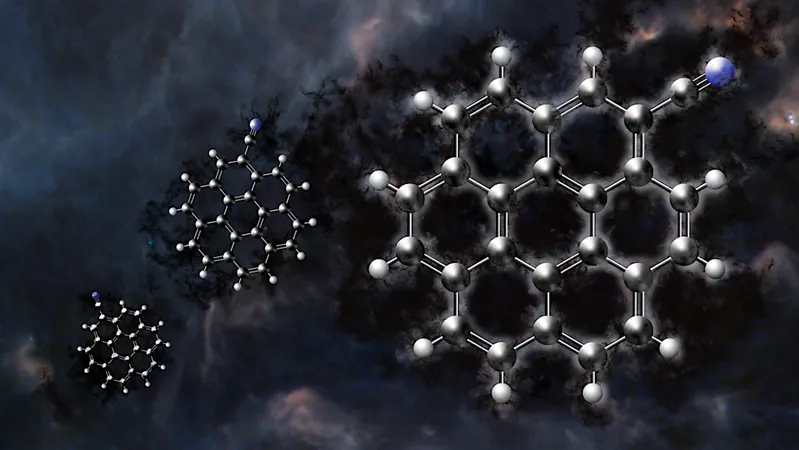
Astrophysical Breakthrough: The Discovery of the Largest Aromatic Molecule in Deep Space!
2025-06-12
Author: Yu
A Stellar Discovery in Astrochemistry
Astronomers and chemists have made a jaw-dropping discovery that could change our understanding of the cosmos: the identification of cyanocoronene, the largest polycyclic aromatic hydrocarbon (PAH) ever found in space. This giant molecule, featuring seven interconnected benzene rings and a cyano group (C24H11CN), was discovered in the cold, dark molecular cloud TMC-1—an area celebrated for its rich chemistry and as a stellar birthplace.
Cyanocoronene: From Lab to the Cosmos
Cyanocoronene is an intriguing derivative of coronene, a compact PAH known for its stability. Until now, our cosmic explorations had only unveiled smaller PAHs, making this discovery a milestone that shatters previous size expectations. PAHs are believed to sequester a substantial portion of the universe’s carbon and are crucial for the chemistry that initiates star and planet formation.
Unveiling the Molecule
But how did astronomers spot this behemoth? The research team first created cyanocoronene in the lab and analyzed its unique microwave spectrum using cutting-edge spectroscopic methods. With this molecular fingerprint, they scoured data from the Green Bank Telescope, part of the GOTHAM project, aimed at hunting aromatic molecules in TMC-1. Their efforts paid off, yielding a remarkable statistical significance of 17.3 sigma in confirming cyanocoronene’s presence.
A Cosmic Reservoir of Carbon
Cyanocoronene now proudly claims the title of the largest individual PAH detected in interstellar space, showcasing 24 carbon atoms in its primary structure. The quantities found are on par with smaller PAHs, suggesting that rather than being scarce, larger aromatic molecules may be abundant across the cosmos. This hints at the possibility of even more complex molecules lurking in the depths of space, potentially providing the essential ingredients for life.
Chemistry Before Stars
The study also reveals that cyanocoronene can form efficiently in the frigid environments of space through reactions between coronene and the CN radical, overcoming the energy barriers typically associated with such processes. This finding suggests that the birth of complex organic compounds may occur even before the stars ignite.
Linking Cosmic Chemistry and Life
The discovery not only enriches our understanding of cosmic chemistry but also bolsters the "PAH hypothesis"—which posits that these molecules are responsible for mysterious infrared emissions detected throughout the universe. It also strengthens the connection between the chemical processes in interstellar clouds and organic material found in meteorites and asteroids, implying that the fundamental building blocks of life may have ancient origins in environments similar to those we find in our solar system.
Looking Ahead
Scientists are excited to probe deeper into the cosmos, searching for even larger PAHs and their derivatives while studying how these molecules thrive in the universe's harsh conditions. Gabi Wenzel, a research scientist at MIT and the lead author, encapsulated the excitement, stating, "Every new detection brings us closer to unraveling the origins of complex organic chemistry in the universe—and perhaps, the very foundations of life itself."

 Brasil (PT)
Brasil (PT)
 Canada (EN)
Canada (EN)
 Chile (ES)
Chile (ES)
 Česko (CS)
Česko (CS)
 대한민국 (KO)
대한민국 (KO)
 España (ES)
España (ES)
 France (FR)
France (FR)
 Hong Kong (EN)
Hong Kong (EN)
 Italia (IT)
Italia (IT)
 日本 (JA)
日本 (JA)
 Magyarország (HU)
Magyarország (HU)
 Norge (NO)
Norge (NO)
 Polska (PL)
Polska (PL)
 Schweiz (DE)
Schweiz (DE)
 Singapore (EN)
Singapore (EN)
 Sverige (SV)
Sverige (SV)
 Suomi (FI)
Suomi (FI)
 Türkiye (TR)
Türkiye (TR)
 الإمارات العربية المتحدة (AR)
الإمارات العربية المتحدة (AR)